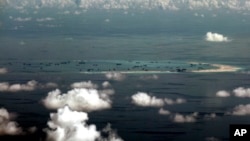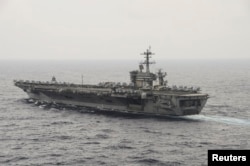A Philippines official says Manila will ask Washington to continue patrols in the South China Sea to ensure freedom of navigation in the area, a strategic passageway for many commercial and military ships, during Tuesday's ministerial level talks in Washington.
Although the possibility of joint patrols by the U.S. and its Asian security allies may also be discussed, analysts see them as unlikely.
“So more operations, yes; but not necessarily jointly with the U.S.,” said Bonnie Glaser, Director of the China Power Project at the Center for Strategic and International Studies (CSIS), a Washington think tank.
Dubbed as the U.S.-Philippines two-plus-two talks, Secretary of State John Kerry and Defense Secretary Ash Carter will meet with their counterparts from the Philippines on Tuesday to discuss regional security issues.
“I can assure you that tensions in the Asia-Pacific region, particularly the South China Sea, will be on the agenda. It's a concern that we and our Philippine friends and allies share, and I suspect they'll have a pretty robust discussion about it tomorrow,” said State Department Spokesman John Kirby on Monday.
Patrols on the quiet
Analyst Glaser said the more frequent patrols might be done quietly.
"They are conducted routinely and normally. They are not intended to be provocative. They are simply intended to be an exercise of freedom of navigation,” said Glaser.
She added that such operations have been conducted all over the world since late 1970s.
Dean Cheng, Senior Research Fellow of the Heritage Foundation, said U.S. maritime patrols are not in support of or in opposition to any state’s territorial claims because the U.S. takes no position on sovereign claims in disputed waters in the South China Sea.
“For the United States, the message is all about freedom of the high seas, the right for ships of all nations to transit international waters unmolested, and rejecting efforts by states to extend their sovereignty claims into international waters,” added Cheng.
Other issues likely to be discussed at the meeting include U.S. military access to the Philippines, possible future arms sales, as well as broader U.S. activities in the Asia Pacific region.
Under the bilateral Enhanced Defense Cooperation Agreement signed by the U.S. and the Philippines in 2014, the U.S. military has access to bases in the Philippines for rotational deployments.
Last October, USS Lassen transited within 12 nautical miles of Subi Reef, one of China's man-made features in the South China Sea. It was accompanied by two U.S. maritime surveillance aircraft.










